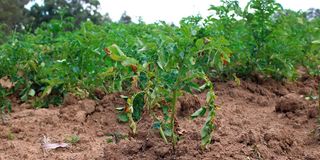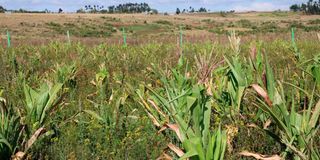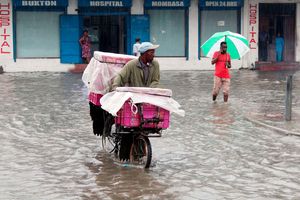Central counties race against time to avert food crisis after poor rainfall warning

Stunted Irish potatoes on a farm in Ol Joro Orok Constituency, Nyandarua County, due to drought, on February 11, 2025. Wilting becomes more severe under dry conditions.
What you need to know:
- Nyandarua, Murang’a, Nyeri, and Laikipia are likely to experience significantly less rain than usual during the long rain season that normally runs from March to May.
County governments in central Kenya have been thrown into panic after the Kenya Meteorological Department forecasted below-average rains during the upcoming long rain season.
According to the weatherman, counties in the region, including Nyandarua, Murang’a, Nyeri, and Laikipia, are likely to experience significantly less rain than usual during the long rain season that normally runs from March to May.
The prediction has caused concern due to potential impacts on agriculture and water supplies.
Counties like Nyandarua and Nyeri are already raising a red flag over a shortage of staple foods. This is attributed to poor rains during last year’s short rain season (October to November), which lead to total crop failure in some regions.
The counties are now racing against time to avert food crises.
To mitigate the challenge, Nyeri, Murang’a, and Nyandarua counties are ditching maize and beans for more commercialised crops as well as promoting drought-tolerant crops or varieties with shorter maturity periods.
Topping the list of preferred crops in this year’s long rains planting season are vegetables and sunflowers.

Stunted maize on a farm at Endarasha, Nyeri County due to prolonged drought, on February 11, 2025.
In Murang’a County, Governor Irungu Kang’ata’s administration in partnership with Kenya Breweries Limited is promoting commercialised sorghum farming. Agriculture, Trade, and Industrialisation Executive Kimani Mugo says sorghum growing is being promoted in dry parts of the county including Kambiti, Maragua, Kakuzi, Kiharu, and the lower parts of Gatanga.
“Sorghum is a drought-tolerant crop, and as a county, we are ensuring that farmers have access to certified seeds. Under the governor’s instruction, the department has assigned a special team of agricultural extension officers to guide and ensure that growers adhere to best agronomy practices.”
He notes that sorghum is among the neglected or orphaned crops despite its high nutritional and commercial values
Mr Mugo says to further promote sorghum as a commercial and climate-smart crop, Governor Kang’ata is negotiating with potential sorghum processors to partner with Murang’a farmers.
The Kenya Meteorological outlook for long rains will last for less than two months between the last week of March and early May 2025, according to the weatherman.
Guided by the forecast, the Nyeri County Department of Agriculture is raceing against time to avert a food crisis.
During the short rain season, the county received an average of 251mm of rainfall spread over 26 days starting the last week of October.
“The rainfall, which was below normal at 41 per cent, was inadequate for crop production, resulting in reduced yields,” says Finance Executive Robert Thuo, who is also the acting Agriculture executive.
He explains that the distressed rains led to reduction of acreage under maize by 328 hectares.
Currently, maize stocks in Nyeri stand at 7,636 bags against a consumption demand of 16,715 bags per month.
Mr Thuo notes that Nyeri has recorded food market disruptions caused by low purchase power due to high inflations, slow recovery from previous droughts and flood effects, inadequate rains, and frequent incidents of wildlife crop destruction.
Other factors include a lack of capital by farmers to purchase certified seeds and an intermittent supply of subsidised fertilisers for planting and top dressing through the e-voucher system. “Farmers are expecting a decrease in maize production, hence most homesteads are likely to source from the markets. Market prices of staple foods, including maize, beans, and Irish potatoes are likely to increase by 40 per cent of current prices,” says the executive.
To mitigate the challenge, the Nyeri County government has embarked on the distribution of certified seeds for Irish potatoes and beans.
More focus is on Nyota beans, a drought-tolerant variety, where the county government is linking growers with off-takers.
Commercialised sunflower farming has also been given more attention.
In Nyandarua, conflict between farmers and herders from neighbouring counties is arising due to competition over land and water resources, especially in Ndaragua Constituency, where tens of pastoralists are invading private farms.
The county government is now encouraging farmers to diversify to crops with minimal rainfall requirements, with a keen interest in vegetables and sunflower farming for edible oil production.
Agriculture Executive Francis Miring’uthe says commercialised sunflower farming is being undertaken in the dry Kirii and Leshao Pondo wards, while vegetable farming is being promoted in wetter Kinangop, Kipipiri, Ol Kalou, and Ol Joro Orok constituencies.
He notes that Nyandarua, a county listed among Kenya’s food baskets, has maize stocks enough to last up to April.
“By January, our maize stocks stood at 30, 876 metric tonnes against a monthly consumption of 6,379 tonnes. However, the situation might worsen with projected poor rains. We have a deficiency of beans at 2,417 metric tonnes. Our beans stocks by January were 205 metric tonnes against a monthly consumption of 2,622 tonnes,” he says.
The maize stocks are reserves from last year’s long rains.
“A relatively improved harvest during the long rains season was recorded after most farmers planted certified seeds distributed by the county government. The county government was keen on issuing seeds suitable for specific regions.”
The official noted that the biggest challenge is that Nyandarua farmers rely on rain-fed agriculture.
But there is a way out.
“Agricultural extension officers are guiding farmers to grow short-season crops like pulses and horticultural crops,” adds Mr Miring’u.
The department is also advising farmers to prepare their land, select seeds suitable for the local climate and gather all the necessary inputs before the onset of the rains.
In Nyandarua, the prices of maize have since December increased from Sh2,500 per bag to Sh3,500 per bag, while those of beans have increased from between Sh140 and 300 per kilo, depending on the variety.
Ndaragua MP George Gachagua says a lasting solution is a shift to irrigation farming.
“We need to focus more on irrigation farming, especially in Ndaragua, which is a drier area. We are lobbying with the national government and other agencies for more irrigation projects. We have already successfully lobbied for the Simbara irrigation dam, but we need more. Karagoini Water Project is also earmarked for completion to serve the lower Ndaragua region with irrigation water,” says Mr Gachagua.





